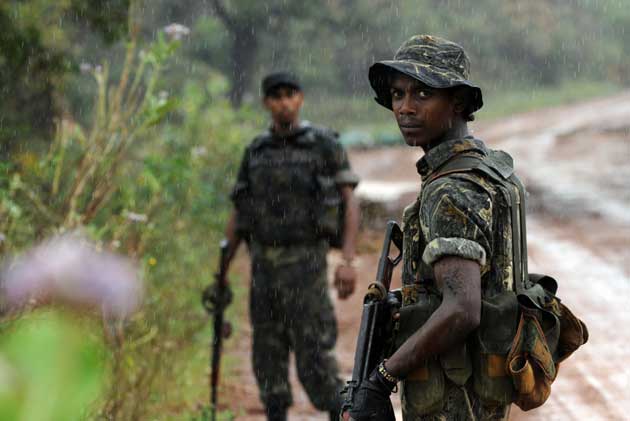Sri Lanka: The war the world forgot
As the Tamil Tigers' rebel army faces defeat, the government has closed off the war zone, causing a humanitarian crisis for those trapped by the fighting. Andrew Buncombe reports

All but hidden from view of the outside world, a bitter and savage war being waged in the north of Sri Lanka is creating a humanitarian crisis in which hundreds of thousands of civilians are at risk.
In what may be the final chapters of one of the world's longest-running civil wars, Sri Lankan troops say they are close to crushing the remnants of the once-potent Liberation Tigers of Tamil Eelam (LTTE). Yet the military operation comes at a high price for civilians.
Aid groups and officials say that dozens of civilians trapped in the war zone are being killed and wounded every day. Determined to press ahead with its operation against a guerrilla force that has in the past ruthlessly attacked both military and civilian targets, the Sri Lankan government refuses to effect a ceasefire that would allow the evacuation of wounded people. It has also shut off the area from the outside world.
"Civilians are continuing to be killed in large numbers," said Gordon Weiss, a UN spokesman. "There are still a lot of people trapped up there and there is no sign of a ceasefire. We have no real access to the area."
The fighting taking place in the Mullaittivu district of Sri Lanka is the conclusion of more than a year of renewed conflict between the LTTE and government troops following the termination of a shaky ceasefire agreement in January 2008. Sri Lanka's President, Mahinda Rajapaksa, has been determined to crush the rebels, seemingly with little regard for the civilian population – a state of affairs he claims has been exaggerated by aid groups and the media.
This week, however, the world had a rare glimpse of the horrors suffered by the Tamil population, trapped between the government troops and rebels. Hundreds of wounded people were taken by the Red Cross by ferry from a makeshift clinic in the war-zone town of Putamattalan to a hospital in the eastern city of Trincomalee. Many of those who were injured reported that they had been fired on by LTTE fighters when they sought to cross the front line to the government side.
"My wife and child got killed in the shooting by the rebels," said 23-year-old Selvadorai Thavakumar, from Kilinochchi, the former rebel capital.
Another patient, Manoharan Mahendran, said: "We did not have food for days, so we decided to flee to the government area. The rebels blocked us and tried to prevent us fleeing."
That the LTTE fighters are capable of such behaviour against Tamil civilians does not appear to be in doubt. Aid groups have complained that they have used ordinary people as human shields, and last week a female suicide bomber, reportedly dispatched by the Tigers, killed around 30 civilians and troops at a checkpoint. Yesterday the Sri Lankan military said that a civilian was killed and another 13 wounded after a rebel threw a hand grenade into a bus of Tamil refugees in the village of Puliyankulam.
Yet the Sri Lankan government has also been widely criticised. Humanitarian officials have said that civilians inside a supposed safe zone were killed by artillery shells fired by both sides. A hospital also came under fire and had to be evacuated, meaning there was no longer a proper medical facility inside the war zone.
Yesterday a spokeswoman for the International Committee of the Red Cross (ICRC) said it was still talking with both sides about entering the conflict zone and evacuating more people from Putamattalan, where large numbers of desperate civilians are arriving every day at a school set up as a makeshift receiving centre.
T Satyamurthy, a doctor working there, said that around 100 wounded civilians were arriving daily and that most had shrapnel wounds. He did not know who had fired the shells. "On Friday, nearly 100 civilians were admitted for injuries; on Thursday 87 admitted. They have injuries from shells, burn marks, but we don't have basic medicine to treat them," he said.
Sophie Romanens, the ICRC spokeswoman, added: "Our other concern is for the welfare of civilians trapped inside the war zone. They have left everything behind. No humanitarian aid has reached them since January 29. We are negotiating for safe passage to allow us to evacuate them."
The Sri Lankan government appears determined that the war being waged in the north remains out of sight of the international community. Journalists have been banned from the war zone, except those travelling on specially escorted tours. Sri Lankan journalists, meanwhile, have suffered a wave of intimidation. Editors have been threatened and many others detained without charge. Around 14 journalists have been murdered by unknown assailants, most recently Lasantha Wickrematunga, editor of The Sunday Leader.
The LTTE has been fighting for a homeland for more than 25 years, claiming the Tamil minority is discriminated against by the Sinhalese-dominated establishment. The war has led to the deaths of at least 70,000 people.
Join our commenting forum
Join thought-provoking conversations, follow other Independent readers and see their replies
Comments